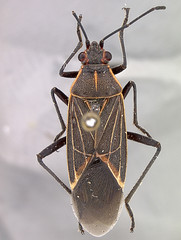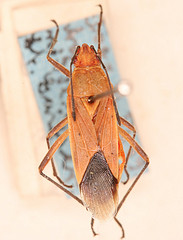Boisea fulcrata fulcrata (Germar 1838)

Range: East and South Africa
Hosts: Acer buergerianum (Trident Maple), Blighia unijugata (Ackee or Triangle Tops), and Pappea capensis (Jacket Plum)
Physical description: About 8 to 12 mm in length. Dorsal side is brownish black with orange margins around the eyes and corium (especially thick along the margin of the corium that borders the membrane) and orange striations running down the length of the corium. Margins of the scutellum that border clavus are similarly orange. Membrane is brown. The brightness of the orange margins may vary, but typically the thick orange margins of the posterior part of the corium are clear and form an orange upside down 'v' shape around membrane. Pronotum becomes very narrow anteriorly, making it appear more triangular in shape than trapezoidal. A distinct orange center line typically runs down the pronotum (not down the entire length) and the sides of the pronotum may be orange. Ventral side is mostly orange, red, or ochre and coxae are similarly colored. Appendages are black.
Boisea fulcrata flava (Bergroth 1912)
Range: northern regions of West Africa
Host: Blighia unijugata
Physical description: About 8 to 13 mm in length. Nearly identical to fulcrata except all places where fulcrata is dark brown or black in color, flava is orange. The striations on flava are more yellowish instead of orange (as they are on fulcrata) and contrast less with the overall color. Appendages are much lighter than they are in fulcrata and are more of a light brown color than black.
Distribution
Red markers = locations of collection sites
Blue regions of land = inferred range
3/4 inch = 1000 miles
Click here for an interactive version of this map.
References
- Göllner-Scheiding, U. (1980): Revision der afrikanischen Arten sowie Bemerkungen zu weiteren Arten der Gattungen Leptocoris Hahn, 1833, und Boisea Kirkaldy, 1910. Dtsch. ent. Z., N.F. 27, 103-148. (English translation)
- Göllner-Scheiding, U. (1983): General-Katalog der Familie Rhopalidae (Heteroptera). Mitt. Zool. Mus. Berlin 59, 37-189.



